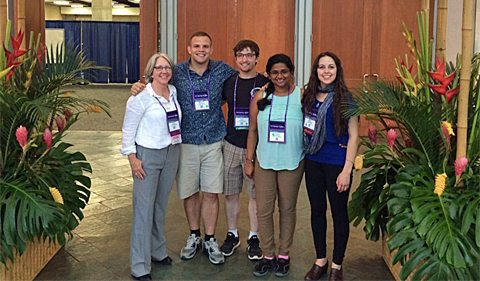
Dr. Sarah Wyatt and her lab group: Alex Meyers, Colin Kruse, Proma Basu, Anne Sternberger in Hawaii
Dr. Sarah Wyatt and members of her research group presented their research—some of it resulting from their 2015 experiment on the International Space Station—at Plant Biology 2017 at Honolulu from June 24-28.
Wyatt is Professor of Environmental & Plant Biology and Director of the Interdisciplinary Molecular and Cellular Biology Program.
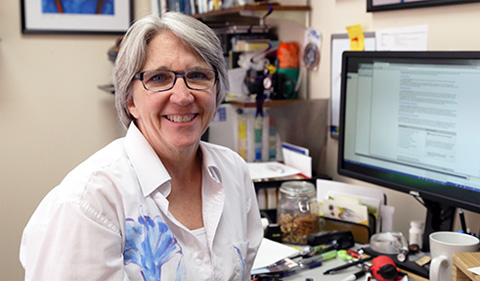
Dr. Sarah Wyatt
Sternberger, Wyatt Gives Talk on Wikipedia in the Science Classroom
Anne L. Sternberger, a Ph.D. student in Environmental & Plant Biology, and Wyatt presented a joint talk during the education concurrent session on their work to include “Wikipedia in the Science Classroom” to enhance writing for the general public.
Abstract: Wikipedia is currently the top online educational resource and serves as one of the most powerful means of publicizing information. The Wiki Education Foundation (Wiki Ed) was incorporated into Wikipedia’s Education Program in 2013 to promote and enhance academic research and teaching. Wiki Ed provides opportunities for faculty and students to access, evaluate and contribute to course-related content on Wikipedia. This in turn allows academic associations to bolster the content and accuracy of publicly available information within their discipline and teaches students invaluable critical thinking and editing skills. We have currently brought Wiki Ed’s programs to the classrooms of four scientific courses at Ohio University including an introductory biology course and three upper division undergraduate and graduate scientific writing courses. Our objectives were two-fold 1) inward facing: teaching students about how the content of Wikipedia is generated and thus how to use Wikipedia more effectively and 2) outward facing: to increase and enhance scientific content. Students were instructed to select research topics of interest within the scope of the course and select an article to critically evaluate. Evaluations followed the criteria set forth by Wiki Ed and were submitted to the talk page of each corresponding article, enabling the public to also view student comments and suggestions. Following evaluations, students edited their articles based on their critiques and classroom discussions. Our student editors have contributed to 43 articles, with 612 edits and 24,350 words added, and these articles have been viewed over 722,000 times. Post-course surveys indicated that students found the exercises to be informative and empowered many to make continued contributions outside of the classroom.
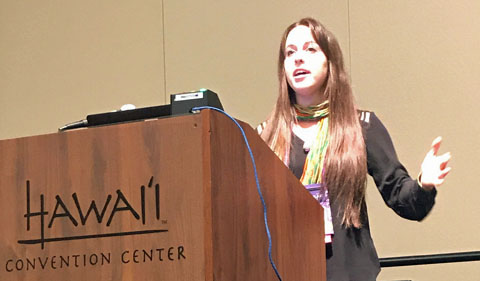
Anne Sternberger
Sternberger Presents Poster on Mixed Breeding System in Viola pubescens
Sternberger also presented a poster on her research with collaborators at Michigan State on “An Interdisciplinary Approach Investigating the Ecology and Underlying Genetic Basis of the Chasmogamous/Cleistogamous Mixed Breeding System in Viola pubescens (Violaceae),” co-authored with Dr. Harvey Ballard, Professor of Environmental & Plant Biology, and Wyatt at OHIO and Megan J. Bowman and Kevin L. Childs at Michigan State.
Abstract: The chasmogamous/cleistogamous mixed breeding system (MBS) comprised of chasmogamous (CH), cross-pollinated, and cleistogamous (CL), self-pollinating flowers, is a successful and widespread reproductive strategy in the angiosperms. While most temperate CH/CL MBS species produce CH flowers in spring and CL flowers summer-fall, both flowers can be selectively induced outside of their seasonal pattern in response to ecological cues. While the specific cues and underlying genetic basis of the CH/CL MBS remain unknown, preliminary evidence suggests that temperature and/or light quality may be responsible for triggering selective floral development, and that the differential expression of genes involved in light and temperature sensing regulates the shift from CH to CL flowers. To investigate the underlying ecophysiological and genetic basis of the CH/CL MBS in V. pubescens, an integrative approach employing ecological, molecular, and bioinformatics analyses was utilized. To analyze the environmental parameters driving selective development of CH and CL flowers, measurements of temperature, light intensity, soil moisture, soil pH, canopy cover and floral counts were collected in local populations (n=10 plots) over a four-month period. Zero-inflated Poisson regressions against the data indicated that in CH floral production, soil pH (p=0.0008), mean temperature (p=0.0004), and minimum temperature (p=0.005) were significant. For CL production, soil pH (2.03e-06), mean temperature (1.08e-05), and max temperature (0.06) were significant. To support the use of V. pubescens in genetic studies, the genomic DNA of V. pubescens was sequenced and assembled into 157,722 scaffolds. To annotate the genome, RNA was extracted from eight V. pubescens tissues resulting in ~480,000,000 reads, which were assembled into a transcriptome with >30,000 transcripts. Structural and functional annotation of the transcriptome was accomplished through the MAKER pipeline. Differential expression analyses of the RNAseq data are ongoing and may highlight gene candidates that play a role in producing either CH or CL flowers.
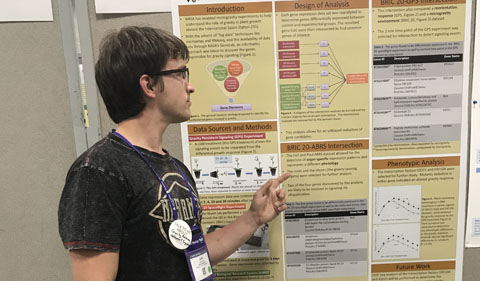
Colin Kruse
Kruse Presents Poster on Gravity Response Genes
Colin Kruse, a Ph.D. student in Plant Biology and Molecular and Cellular Biology, presented a poster titled “At the Intersection: Identification and Characterization of Fundamental Gravity Response Genes.”
Abstract: Plants have evolved to use the ever-present stimulus of gravity as a source of information. In plants, gravity is sensed in individual cells within the root cap columella and the endodermis of the shoots, suggesting a fundamental cellular response mechanism. To identify key elements involved in the cellular response to gravity, we analyzed the intersection of transcriptomic data from our Arabidopsis seedlings flown to the space station, an additional spaceflight gene expression data set from the GeneLab repository and a data set from a ground-based experiment assessing gene expression after reorientation with respect to gravity. Each gene expression data set selected was analyzed to determine genes differentially expressed between control and experimental groups. The resultant gene lists were then intersected to find common genes of interest. Five genes (ERF104, IQ21, MSRB6, PP2-A13 and AT4G23670) were found to be upregulated within two minutes of reorientation on Earth and downregulated under microgravity conditions or vice versa. Four additional genes (XTH24, ATL31, ATL23 and AT1G78820) were found to be differentially expressed in both spaceflight experiments and exclusively in the gravisensing organs (roots and hypocotyls). Based on functional analysis of protein domains and existing annotations, five of these genes (ATL31, ATL23, ERF104, IQD21 and PP2-A13) indicate a role in gravity signaling. Knockout mutants, iqd21, pp2-a13 and erf104, have been shown to have altered response to gravity phenotypes. Determining the regulatory roles of these genes advances the fundamental understanding of plant gravitropism and cellular signaling as a whole. The success of the intersection approach furthers our understanding of gravity response in plants and provides motive to apply the approach to other complex signaling events in a variety of organisms. This work was partially funded by NASA (#NNX13AM48G to SEW and DRL) with supplemental funding provided by NASA GeneLab.
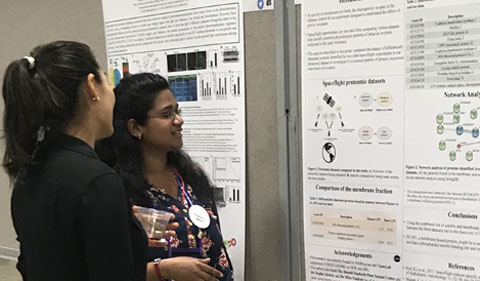
Proma Basu
Basu Presents Poster on Candidate Genes for Gravity Signaling
Proma Basu, a Ph.D. student in Plant Biology and Molecular and Cellular Biology, presented a poster titled “Spaceflight proteomics identifies candidate genes for gravity signaling,” co-authored with Kruse and Wyatt.
Abstract: Spaceflight provides a salient control in the study of gravitropism. As the receptor in any cellular signaling model is usually a membrane bound protein, a proteomic study comparing the proteins in seedlings germinated on ISS to Earth can help identify such a receptor for gravity. For this study Arabidopsis Wild Type Col-0 seeds were sterilized and plated on 60mm petri plates. These plates were packed in spaceflight hardware and flown to the International Space Station (ISS). A duplicate set of WT Col-0 seeds were kept on Earth as a ground control. After return from the ISS, proteins were extracted and fractionated into membrane and soluble fractions. Both fractions were analyzed using labelled tandem mass spectrometry at Donald Danforth Plant Science Center. Differential abundance analysis revealed 163 soluble proteins and 167 membrane proteins between spaceflight and ground samples (p < 0.05). To date only two other proteomics experiments have compared the spaceflight proteome of Arabidopsis seedlings. One compared the soluble proteome and identified 546 differentially abundant proteins while the other compared membrane proteome and identified 149 proteins. As our study had compared both soluble and membrane proteomes therefore identifying the proteins that were common across all three datasets would give us insight into the expression pattern of proteins that are commonly perturbed in all spaceflight experiments. The intersection dataset identified two membrane proteins and twelve soluble proteins. A network analysis was done on the fourteen proteins using String DB which identified two interactions. One was due to the proteins (AT3G62870 and STV1) working together during translation. The other was between PCAP1, a membrane bound protein with a phosphatidyl inositol binding site, and a soluble protein (PATL2) which is a membrane trafficking protein. These proteins therefore can be candidate genes for gravity signal transduction. This work was partially funded by NASA grant # NNX13AM48G to SEW and DRL.
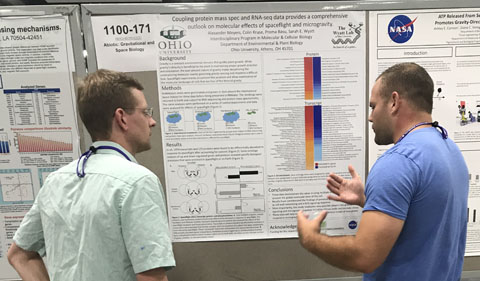
Alexander Meyers
Meyers Presents Poster on Molecular Effects of Spaceflight and Microgravity
Alexander Meyers, a Ph.D. student in Plant Biology and Molecular and Cellular Biology, presented a poster on “Coupling protein mass spec and RNA-seq data provides a comprehensive outlook on molecular effects of spaceflight and microgravity” co-authored with Kruse, Basu and Wyatt.
Abstract: Gravitropism is a plant’s ability to sense its own orientation with respect to gravity and control its direction of growth accordingly. Gravity is important for proper growth and development of many plants, but there are major gaps in our knowledge of how gravitropism works on the molecular level. The ubiquitous nature of gravity on Earth makes experimental design problematic, with spaceflight ventures being the only way to truly provide an environment free of the gravity stimulus. Thus, the International Space Station (ISS) was utilized to test gene regulation in response to gravity. Arabidopsis seedlings were grown aboard the ISS for three days before being chemically fixed, frozen, and returned to Earth for RNA sequencing and mass spec protein analysis. Over 2,000 genes (FDR≤0.05) and over 300 proteins (p≤0.05) were found to be in differential abundance between the spaceflight and ground-grown samples. These genes and proteins are involved in pathways ranging from calcium transport and vesicle transport to metabolism and growth, and represent changes in the molecular environment induced by microgravity. The functional interpretation of these data may require more scrutiny, however, as plants cannot have evolved a natural response to microgravity conditions, and much of what we see may not be specific to gravity signaling. With seemingly aberrant expression or activation of some genes and stress pathways, careful inspection of these data has been necessary to extract genes directly linked to gravity signaling. Building on knowledge gained from years of Earth- and microgravity-based investigations, we have uncovered several avenues for future research and discovery



















Comments